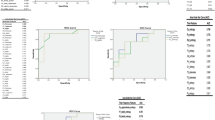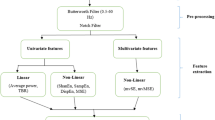Abstract
Attention deficit hyperactivity disorder is a complex brain disorder which is usually difficult to diagnose. As a result many literature reports about the increasing rate of misdiagnosis of ADHD disorder with other types of brain disorder. There is also a risk of normal children to be associated with ADHD if practical diagnostic criteria are not supported. To this end we propose a decision support system in diagnosing of ADHD disorder through brain electroencephalographic signals. Subjects of 10 children participated in this study, 7 of them were diagnosed with ADHD disorder and remaining 3 children are normal group. Our main goal of this sthudy is to present a supporting diagnostic tool that uses signal processing for feature selection and machine learning algorithms for diagnosis.Particularly, for a feature selection we propose information theoretic which is based on entropy and mutual information measure. We propose a maximal discrepancy criterion for selecting distinct (most distinguishing) features of two groups as well as a semi-supervised formulation for efficiently updating the training set. Further, support vector machine classifier trained and tested for identification of robust marker of EEG patterns for accurate diagnosis of ADHD group. We demonstrate that the applicability of the proposed approach provides higher accuracy in diagnostic process of ADHD disorder than the few currently available methods.








Similar content being viewed by others
References
Biederman, J., and Faraone, S. V., Attention-deficit hyperactivity disorder. Lancet 366:237–248, 2005.
Castellanos, F. X., Toward a pathophysiology of attention-deficit/hyperactivity disorder. Clin. Pediatr. 36(7):381–393, 1997.
Barry, R. J., Clarke, A. R., and Johnstone, S. J., A review of electrophysiology inattention-deficit/hyperactivity disorder: I. Qualitative and quantitative electroencephalography. Clin. Neurophysiol. 114:171–183, 2003.
Loo, S. K., and Barkley, R. A., Clinical utility of EEG in attention deficit hyperactivity disorder. Appl. Neuropsychol. 12(2):64–76, 2005.
Barry, R. J., Johnstone, S. J., and Clarke, A. R., A review of electrophysiology in attentiondeficit/hyperactivity disorder: II. Event-related potentials. Clin. Neurophysiol. 114(2):184–198, 2003.
Barkley, R. A., Attention deficit hyperactivity disorder: A handbook for diagnosis and treatment, 2nd edn. Guilford Press, 1999.
Elder, T. E., The importance of relative standards in ADHD diagnoses: Evidence based on exact birth dates J. Health Econ. 29:642–656, 2010.
Barry, R., Kirkaikul, S., and Hodder, D., EEG alpha activity and the ERP to target stimuli in an auditory oddball paradigm. Int. J. Psychophysiol. 39:39–50, 2000.
Chabot, R. J., and Serfontein, G., Quantitative electroencephalographic profiles of children with attention deficit disorder. Biol. Psychiatry 40:951–963, 1996.
Clarke, A. R., Barry, R. J., McCarthy, R., and Selikowitz, M., EEG analysis in attention-deficit/hyperactivity disorder: A comparative study of two subtypes. Psychiatry Res., 81:19–29, 1998.
Clarke, A. R., Barry, R. J. McCarthy, R., and Selikowitz, M., EEG-defined subtypes of children with attention-deficit/hyperactivity disorder. Clin. Neurophysiol., 112:2098–2105, 2001.
Lazzaro, I., Gordon, E., Whitmont, S., Plahn,M., Li, W., Clarke, S., et al., Quantified EEG activity in adolescent attention deficit hyperactivity disorder. Clin. Electroencephalogr., 29:37–42, 1998.
Mann, C. A., Lubar, J. F., Zimmerman, A. W., Miller, C. A., and Muenchen, R. A., Quantitative analysis of EEG in boys with attention-deficit-hyperactivity disorder: Controlled study with clinical implications. Pediatr. Neurol., 8(1):30–36, 1992.
Mueller, A., Candrian, G., Kroptov, J. D., Ponomarev, V., and Baschera, G. M., Classification of ADHD patients using a machine learning system. Nonlinear Biomed. Phys., 4(1):1–12, 2010.
Anduradha, J., Tisha, Ramachandran, V., Arulalan, K. V., and Tripathy, B. K., Diagnosis of ADHD using SVM algorithm. In: COMPUTE2010, ACM Proceedings. Bangalore, India, January 22–23, 2010.
Ahmadlou, M., and Adeli, H., Wavelet-synchronization methodology: A new approach for EEG-based diagnosis of ADHD. Clin. EEG Nurosci. 41(1):1–10, 2010.
American Psychiatric Association, American Psychiatric Association: Diagnostic and statistical manual of mental disorders DSM-IV., 4th edn., 1994.
Oh, K., Hong, K. M., Lee, H., and Ha, E., K-CBCL. Seoul, Korea: Chung Ang Aptitude Publishing Co., 1997.
Anastopoulos, A. D., Spisto, M., and Maher, M. C., The WISC-III freedom from distractibility factor: Its utiliity in identifying children with attention deficit hyperactivity disorder. Psychol. Assess. 6:368–371, 1994.
Cover, T. M., and Thomas, J. A., Elements of information theory. Wiley: Chichester, 2006.
Cristianini, N., and Shawe-Taylor, J., Support vector machines and other kernel based learning methods. Cambridge: Cambridge University Press, 2000.
Cortes, C., and Vapnik, V. N., Support-vector networks. Mach. Learn., 20:273–297, 1995.
Acknowledgements
We thank our colleagues who provided assistance in data acquisition sessions. Especially, we appreciate the efforts of Dr. Yunhee Shin and her research group during the research collaboration (Daegu Univ., ROK) and their fruitful discussions about the ADHD children. We are also immensely grateful to reviewers for their useful comments on an earlier version of themanuscript. This work was supported by the Daegu Gyeongbuk Institute of Science and Technology and funded by the Ministry of Education, Science and Technology of the Republic of Korea.
Author information
Authors and Affiliations
Corresponding author
Rights and permissions
About this article
Cite this article
Abibullaev, B., An, J. Decision Support Algorithm for Diagnosis of ADHD Using Electroencephalograms. J Med Syst 36, 2675–2688 (2012). https://doi.org/10.1007/s10916-011-9742-x
Received:
Accepted:
Published:
Issue Date:
DOI: https://doi.org/10.1007/s10916-011-9742-x




